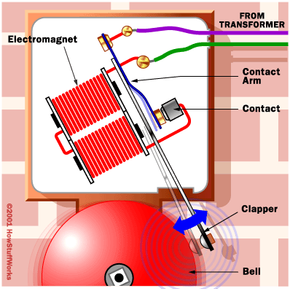Buzzer and Bell
As we saw in the last section, an electromagnet consists of a single length of wire wrapped in a coil. In a buzzer, the simplest sort of doorbell, an electromagnet is used to operate a self-interrupting circuit.
When the circuit is closed, the electromagnet is magnetized so it pulls up on the contact arm. This breaks the doorbell circuit, which shuts off the electromagnet. The arm falls down, closing the circuit again and the process repeats.
Advertisement
One end of the electromagnet wire is connected directly to one end of the electrical circuit. The other end of the wire connects to a metal contact, which is adjacent to a moving contact arm.
The contact arm is a thin piece of light, conductive metal, with a thin iron bar soldered onto it. The anchored end of the contact arm is wired to the electrical circuit. When the electromagnet is turned off, the free end of the arm rests against the contact point. This forms a connection between that end of the wire and the electrical circuit. In other words, electricity can flow through the electromagnet when the circuit is closed.
Closing the doorbell circuit (by pressing the button) puts this mechanism in motion. Initially, the electromagnetic field attracts the iron bar, which pulls the contact arm off the stationary metal contact. This breaks the connection between the circuit and electromagnet, so the electromagnet shuts off.
Without a magnetic field pulling it back, the contact arm snaps back into position against the stationary contact. This reestablishes the connection between the electromagnet and the circuit, and the current can flow through it again. The magnetic field draws the contact arm up, and the process repeats itself as long as you hold down the buzzer button. In this way, the electromagnet keeps shutting itself on and off.
The buzzing noise you hear is the sound of the rapidly moving arm hitting the magnet and the stationary contact dozens of times a second.
A bell system works on exactly the same idea, except the moving arm is attached to a long clapper, which rests alongside a circular bell. As the arm moves back and forth, the clapper hits the bell repeatedly. This is the same system used in old-fashioned fire alarms and school bells.
These days, most people don't have buzzers or bells in their homes. The standard doorbell design today makes a softer chiming sound. In the next section, we'll see how this system works.
